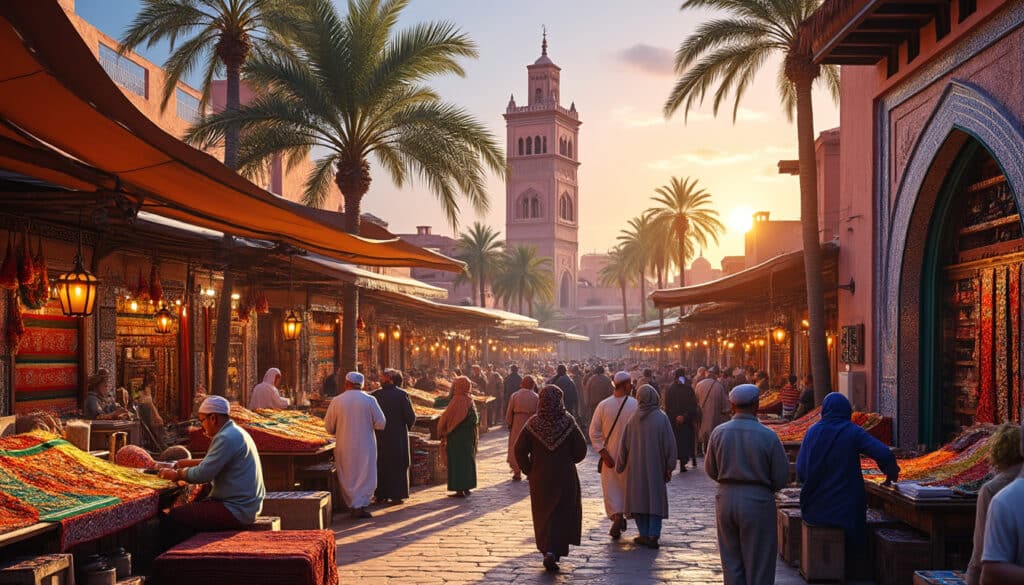The city of Marrakesh, often also spelled as Marrakech, is more than just a destination known for its vibrant souks and stunning palaces. It’s a melting pot of cultures, languages, and history that reflect the dynamic interplay of evolution and tradition. As the fourth-largest city in Morocco and a renowned UNESCO World Heritage site, Marrakesh represents a mosaic of linguistic diversity that makes it truly unique. Located near the foothills of the Atlas Mountains, this city is a vital economic center and a focal point of tourism, attracting millions of visitors each year. This article explores the complexities of Marrakesh’s language, its unique spelling variations, and the rich tapestry of its historical and cultural influences.
Linguistic Tapestry of Marrakesh: More Than Just Words
Marrakesh is not just a city; it is a linguistic tapestry that weaves together myriad strands of communication, history, and culture. First and foremost, the official language of Morocco, Modern Standard Arabic, holds a prominent position in the heart of Marrakesh, used in formal settings such as schools, media, and government institutions. However, the everyday language spoken by Marrakshis leans heavily on Darija, a rich and colorful Moroccan Arabic dialect that is peppered with Berber, French, and Spanish influences.
Berber Influence: The indigenous Berber (Amazigh) population has also left an indelible mark on the city’s linguistic landscape. Marrakesh was historically a major hub for Amazigh culture, and the echoes of this heritage can be heard today in the widespread use of Tashelhit, a Berber dialect, especially in the rural areas surrounding the city.
- 🏞️ Berber words frequently used in the city, especially in Medina markets.
- 🗣️ Tashelhit fluency among the older generations helps preserve cultural identity.
- 📚 Education systems are progressively integrating Berber languages into curricula.
French Influence: The French language too plays a significant part in the day-to-day lives of those residing in Marrakesh. French is often the language of business and administration, thanks to Morocco’s former status as a French protectorate from 1912 to 1956. Many signboards, menus, and official documents are bilingual, often found in both French and Arabic.
The linguistic environment of Marrakesh also underscores the rising importance of English, particularly in tourist areas and international business settings, reflecting the city’s expanding global connections. As a result, multilingualism is not uncommon, as individuals navigate between these various tongues with remarkable fluidity.
Furthermore, cultural festivals and events provide vibrant opportunities for the celebration of this multilingual heritage, where music, poetry, and storytelling thrive in multiple languages, offering a rich tapestry that reflects Marrakesh’s inclusive spirit.
| Language | Usage Context | Example Words/Phrases |
|---|---|---|
| Modern Standard Arabic | Formal settings, media, and education | “As-salamu alaykum” (Peace be upon you) |
| Darija (Moroccan Arabic) | Everyday communication | “La bas” (How are you?) |
| Tashelhit (Berber dialect) | Cultural and traditional contexts | “Azul” (Hello) |
| French | Business, administration, and education | “Bonjour” (Hello) |
| English | Tourism and international business | “Thank you” |
Spelling Variations: Understanding Marrakesh vs. Marrakech
The question of whether to spell the city’s name as “Marrakesh” or “Marrakech” often intrigues visitors and scholars alike. The duality in spelling reflects the city’s unique position as a crossroads of different cultures and languages. The English spelling “Marrakesh” aligns with the common transliteration from Arabic, while “Marrakech,” the French spelling, stems from Morocco’s historical ties with France. Such variations showcase the complex intertwining of language, culture, and history.
To delve deeper into the etymology, the name “Marrakesh” is said to derive from the Berber words “Amur nukush,” which translates to “Land of God.” This naming theory underscores the link between the city and its indigenous Berber roots. Another possibility suggests that the name came from the Arabic phrase “Mur ākhush,” meaning “Land of God” or “Country of Sons of Kush.” Despite these differing origins, both interpretations highlight Marrakesh’s longstanding spiritual and cultural significance.
- ✍️ “Marrakesh” – Preferred English transliteration.
- ✍️ “Marrakech” – French spelling with historical context.
- 🌍 The name reflects the cultural richness and historical layers of the city.
Several historical accounts reference Marrakesh as the “Kingdom of Marrakesh,” marking its prominence as Morocco’s capital during different historical periods. This reflects the unique evolution of the city’s identity and highlights its central role in the realm’s history. Today, residents and tourists alike use both spellings interchangeably, further solidifying Marrakesh’s role as a bridge between past and present, East and West.
The bilingual nature of Marrakesh’s identity continues to influence its cultural offerings and urban fabric. In the famous Marrakech souks, for example, the linguistic diversity is on full display as tourists navigate through bustling lanes lined with vendors who expertly switch between languages. This etymological and cultural depth continually draws intrigue from scholars and travelers around the globe.
In conclusion, the spelling choice between Marrakesh and Marrakech represents more than linguistic preference; it encapsulates the dynamic interplay of history, culture, and identity that defines this remarkable city and invites deeper exploration.

Cultural Significance of Multilingualism in Marrakesh
In Marrakesh, multilingualism is not just a backdrop but a vibrant aspect of daily life that enhances cultural exchanges and enriches community interactions. With such a diverse linguistic palette, Marrakesh stands as a testament to the power of language in fostering cultural continuity and societal cohesion.
Historically, Marrakesh has served as a meeting point for traders, scholars, and travelers from diverse regions, making it a crucible of cultural exchange. The fluency in various languages empowers Marrakshis to engage with a multicultural world, facilitating exchanges that transcend borders and open gateways to global interactions.
Many cultural festivals and events in Marrakesh celebrate this multilingualism, fostering an environment of appreciation for linguistic diversity. The Marrakech Popular Arts Festival, for instance, is an annual event that showcases performances and art in languages spanning Arabic, Berber, French, and English, reflecting the city’s rich cultural mosaic.
- 🎭 Marrakech Mosaics: A festival highlighting the city’s linguistic and cultural diversity.
- 📖 Poetry and storytelling events feature multilingual presentations.
- 🎶 Music festivals offer performances in different languages.
Moreover, the integration of multilingual education in schools allows the younger generation to navigate the global landscape more efficiently, ensuring that the future of Marrakesh remains connected to its past while embracing global perspectives.
Ultimately, the enriching cultural exchange that thrives in Marrakesh’s multilingual setting enhances tourism, as visitors experience a city that speaks many languages both literally and figuratively. This multilingual charm is central to the allure of Marrakesh, making it a desirable destination for travelers seeking a deeper understanding of Morocco’s diverse heritage and history.
Marrakesh: A Cultural and Linguistic Oasis
Renowned for its historic architecture, bustling markets, and rich cultural heritage, Marrakesh holds a special place as a linguistic oasis within Morocco. The city’s architecture is a physical manifestation of this cultural and linguistic richness, with intricately designed Islamic structures and colorful zellij tiles witnessing centuries of change and adaptation.
Marrakesh’s medina, a UNESCO World Heritage site, is a living labyrinth teeming with life, color, and sound. Here, language weaves itself into the fabric of daily life, echoing through the rhythmic calls of street vendors, the melodious sentences of storytellers, and the gentle negotiations in the souks. These interactions create a vivid tapestry where language continues to play a critical role in weaving the community together.
| Site/Experience | Language Interaction | Key Features |
|---|---|---|
| Jemaa el-Fnaa | Multiple languages in trade and performances | Snake charmers, storytellers, and vendors |
| Medina Souks | Language diversity among artisans and traders | Handicrafts, textiles, and spices |
| Koutoubia Mosque | Historic Arabic calligraphy | Spiritual and architectural symbolism |
The fusion of language and culture in Marrakesh is further showcased in its renowned culinary arts. The city’s cuisine epitomizes the flavors of history, drawing from Arab, Berber, and French influences to captivate the palates of both locals and tourists. Signature Marrakech foods like “tanjia” and “couscous” speak to the city’s geographic and cultural connectivity, as meals become a medium for exchange and exploration.
Marrakesh’s position as a linguistic and cultural oasis continues to resonate in every corner of this enchanting city. As it embraces modernity while safeguarding tradition, Marrakesh remains an enduring symbol of unity in diversity, drawing visitors from all corners to partake in its rich linguistic and cultural legacy.
Preserving Marrakesh’s Linguistic Legacy Amidst Modern Developments
While Marrakesh blossoms as a cultural and economic hub, the preservation of its linguistic heritage presents ongoing challenges and opportunities. As globalization accelerates, balancing modern development with the protection of indigenous languages becomes crucial for maintaining the city’s unique identity.
Efforts to preserve Marrakesh’s linguistic heritage are evident in several initiatives, including educational programs that promote Berber languages alongside Arabic and French. Local organizations and academic institutions work tirelessly to ensure that these languages remain vibrant components of Marrakesh’s cultural landscape.
- 🔍 Language preservation programs: Aim to keep Berber dialects alive in future generations.
- 🎓 Multilingual education: Supports the integration of diverse languages in education.
- 📜 Cultural workshops: Offer language and cultural insights to both locals and tourists.
Moreover, Marrakesh serves as a meeting ground for global artists and intellectuals who engage in dialogues that highlight linguistic diversity as a source of cultural richness rather than a barrier. This engagement tells a broader story of resilience and adaptability as the city navigates its place on the international stage.
Importantly, the use of language as a tool for storytelling and cultural expression in Marrakesh’s vibrant festivals and markets continues to foster community cohesion and preserve traditional narratives. Whether conveyed through song, art, or literature, these expressions serve as tangible connections to the city’s storied past.
As Marrakesh continues to embrace both its historical roots and modern aspirations, it remains a shining example of how linguistic diversity can inspire and connect people on a profound level. By preserving its linguistic legacy, Marrakesh not only sustains its cultural richness but also ensures that future generations can experience the unique spirit of a city that proudly speaks the many languages of its heritage.
FAQs About Marrakesh’s Language and Spelling
- Why is there a difference in spelling between Marrakesh and Marrakech?
“Marrakesh” is the English transliteration, while “Marrakech” reflects the French influence, each embodying different aspects of the city’s cultural history. - What languages are commonly spoken in Marrakesh?
Arabic (Modern Standard and Darija), French, Tashelhit (a Berber dialect), and increasingly, English, especially in areas focused on tourism and international business. - Is Marrakesh a multilingual city?
Yes, Marrakesh is renowned for its multilingual nature, with proficiency in multiple languages being common among residents due to its rich cultural exchanges. - How does Marrakesh’s multilingual culture affect tourism?
The city’s ability to communicate across languages enhances the visitor experience, making it more accessible and engaging for international tourists. - Are there efforts to preserve indigenous languages in Marrakesh?
Yes, various programs and initiatives aim to keep Berber languages vibrant, ensuring they remain integral to Marrakesh’s cultural fabric.

Fun Facts & Curiosities About Marrakesh
Marrakech, the enchanting “Red City” of Morocco, is like a multifaceted jewel that gleams under the North African sun. With its rich history, colorful culture, and architectural marvels, the city is a place where the past and present coexist in…

Architecture and urban features of Marrakesh
Marrakesh, a city bursting with energy and colors, serves as a monumental reflection of centuries of history and blending of cultures. Known for its unique architecture, Marrakesh embodies a fusion of Islamic, Berber, and French colonial styles that delightfully merge…
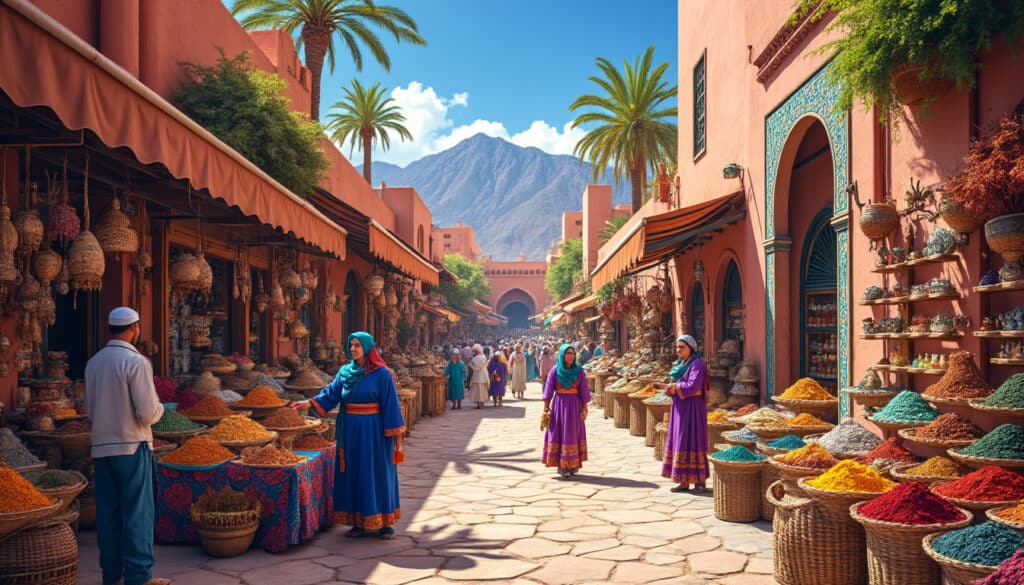
Nestled in the shadow of the magnificent Atlas Mountains, Marrakesh offers a vibrant tapestry of life that weaves together history, culture, and a thriving modern scene. Its bustling streets, scented with the aroma of spices and the buzz of local…
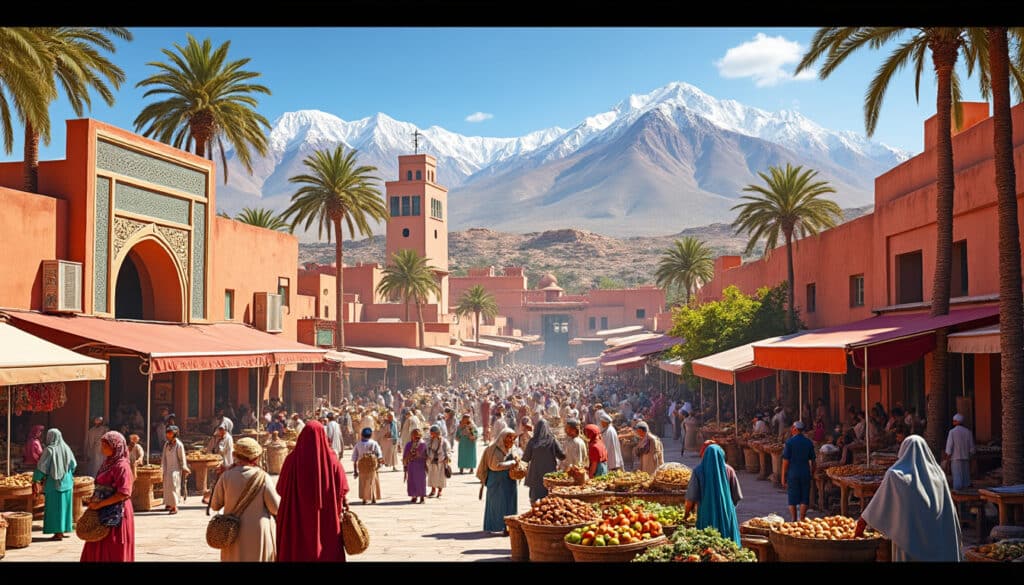
Demographics and geography of Marrakesh
Marrakesh is one of the most vibrant cities in Morocco, a hub of culture, history, and geographical diversity. Located at the foothills of the Atlas Mountains, this city boasts a unique blend of traditional and modern influences that reflect in…

Holidays and celebrations in Marrakesh
Immerse yourself in the vibrant tapestry of Marrakesh, a city brimming with an extraordinary array of holidays and celebrations. From the bustling souks to historic landmarks like the Koutoubia Mosque and the enchanting Majorelle Garden, Marrakesh offers a captivating backdrop…
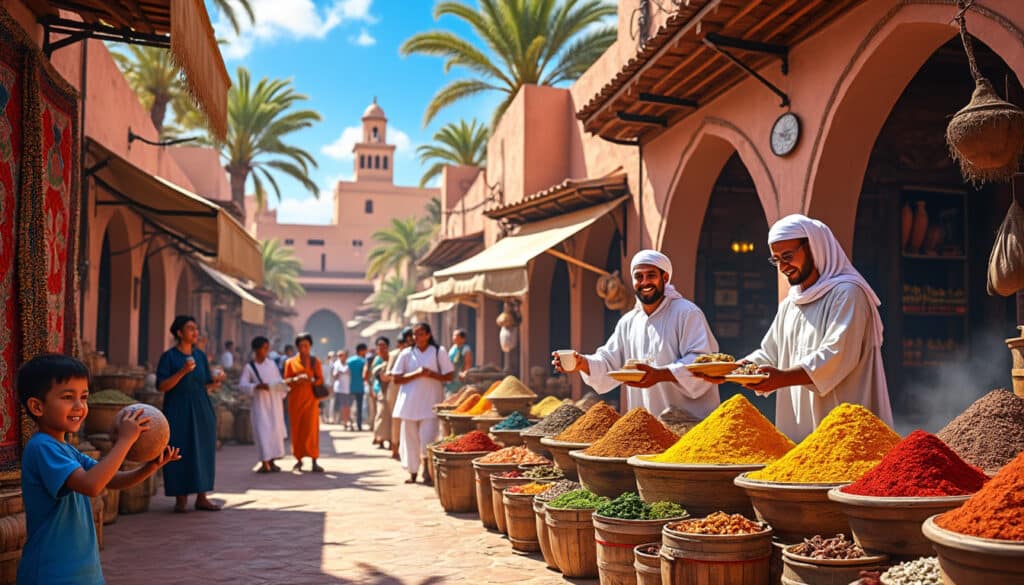
Local tips for tourists in Marrakesh
Marrakech, the captivating heart of Morocco, enchants visitors with its vibrant souks, stunning palaces, and aromatic cuisine. Known as the “Red City” due to its distinctive ocher walls, Marrakech offers a whirlwind of sensory delights that can both overwhelm and…
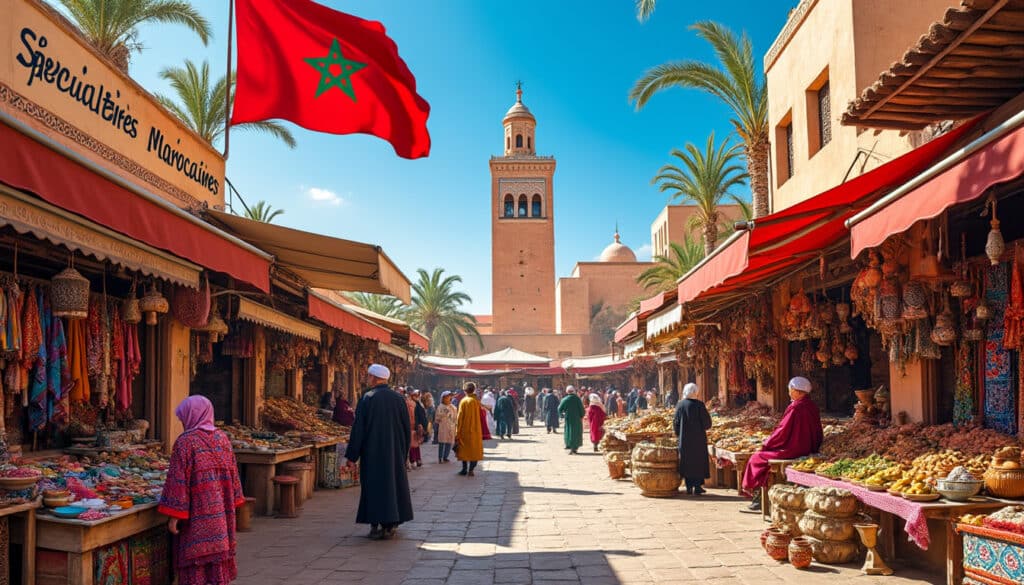
Names, flags, and identity of Marrakesh
Marrakesh, a city steeped in history and vibrant culture, is a tapestry of visual and symbolic elements that resonate with both locals and visitors alike. Known as the “Red City,” Marrakesh is an enchanting fusion of ancient traditions and modern…
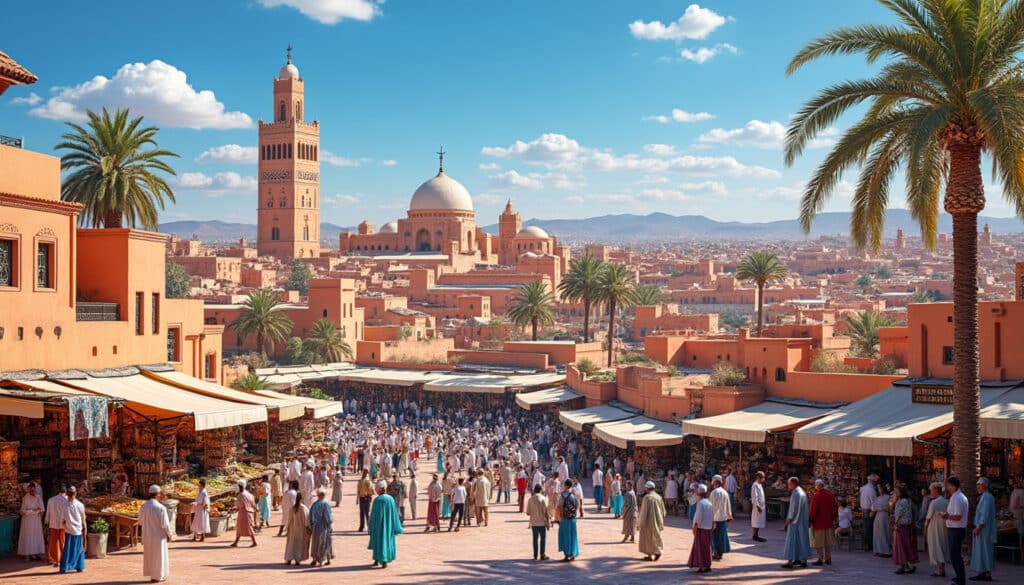
Reputation and identity of Marrakesh
Marrakesh, the “Red City” of Morocco, is a symphony of history, culture, and sensory experiences, where ancient traditions and modern lifestyles coexist beautifully. The city, with its vibrant marketplaces and iconic landmarks, offers a fascinating insight into Moroccan life. Each…
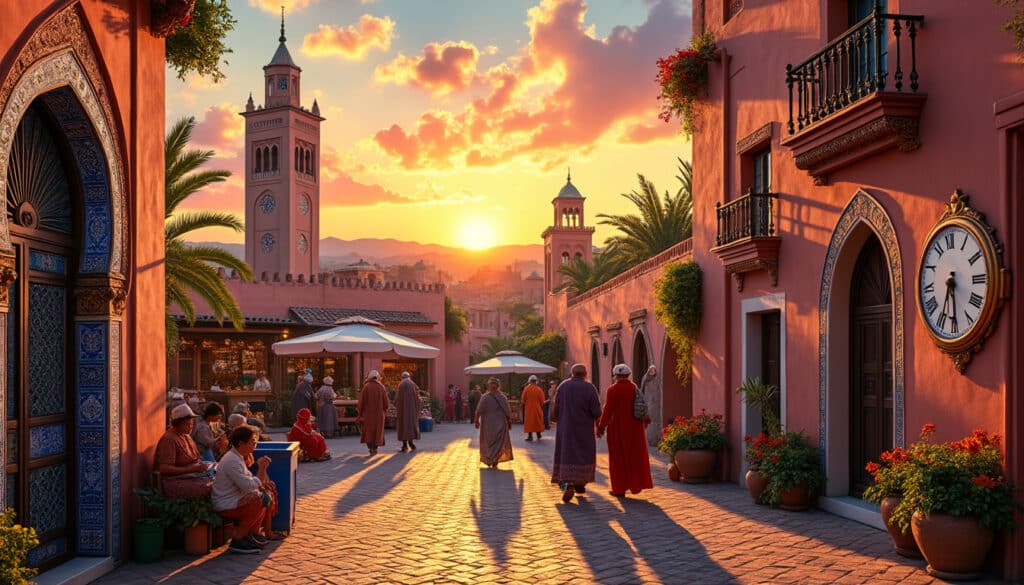
Time and time zone in Marrakesh
Marrakesh, a vibrant blend of history and culture, is a destination that attracts countless travelers every year. Whether you’re planning to experience the labyrinthine souks or explore its majestic palaces, understanding Marrakesh’s local time and timezone is essential for making…

Unusual facts and social issues in Marrakesh
Marrakesh, the captivating “Red City” of Morocco, is not only renowned for its vibrant souks and stunning architecture, but also for its unique blend of cultural and social dynamics that make it a hub of intrigue and diversity. Known for…

What does Marrakesh look, smell, feel like?
Known as the “Red City,” Marrakesh captivates all who visit with its sensory tapestry, created by the intertwining of sights, sounds, smells, flavors, and textures. A city known for its vivid colors, historical richness, and cultural diversity, Marrakesh draws explorers,…



